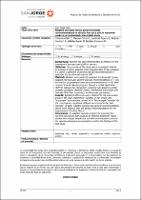Por favor, use este identificador para citar o enlazar este ítem:
https://repositorio.usj.es/handle/123456789/1110
Registro completo de metadatos
| Campo DC | Valor | Lengua/Idioma |
|---|---|---|
| dc.contributor.author | Cimarras-Otal, Cristina | - |
| dc.contributor.author | Marcen-Cinca, Noel | - |
| dc.contributor.author | Rabal-Pelay, Juan | - |
| dc.contributor.author | Lacárcel-Tejero, Belén | - |
| dc.contributor.author | Alcázar Crevillén, Andrés | - |
| dc.contributor.author | Villalba-Ruete, José Antonio | - |
| dc.contributor.author | Bataller-Cervero, Ana Vanessa | - |
| dc.date.accessioned | 2024-02-08T08:27:14Z | - |
| dc.date.available | 2024-02-08T08:27:14Z | - |
| dc.date.issued | 2020-06-01 | - |
| dc.identifier.citation | Cimarras-Otal, Cristina et al. ‘Adapted Exercises Versus General Exercise Recommendations on Chronic Low Back Pain in Industrial Workers: A Randomized Control Pilot Study’. 1 Jan. 2020 : 733 – 740. | en_US |
| dc.identifier.issn | 1875-9270 | en_US |
| dc.identifier.uri | https://repositorio.usj.es/handle/123456789/1110 | - |
| dc.description.abstract | Background Exercise has been demonstrated as effective for the treatment of low back pain (LBP) in workers. Objective The purpose of this study was to investigate whether an exercise program adapted to the characteristics of the workplace is a useful supplement to general exercise recommendations in assembly line workers with chronic LBP. Methods Workers were randomly assigned to intervention group-adapted exercises plus general exercise recommendations (n = 10), and control group-general exercise recommendations (n = 8). Both received 8-week exercise program through a mobile application (APP) to manage the intervention. Outcome was based on lumbar disability (Oswestry Disability Index), interference and lumbar pain intensity (Brief Pain Inventory), and kinematic parameters. Results Significant differences were obtained for the intervention group in the "pain interference" variable, in the "mood" and "enjoyment" sub-variables, as well as in "flexion angle" variable. For the control group, significant differences occurred in the "pain intensity" variable. Adapted exercise plus general recommendations seems more effective than the general recommendations for the improvement of lumbar flexion. Conclusions An adapted exercise program for assembly line workers with chronic LBP could be an effective treatment. Future studies with a larger sample size and with an exhaustive control of the exercise adherence are required to confirm the findings of this pilot study. | en_US |
| dc.format.extent | 8 p. | en_US |
| dc.format.mimetype | application/pdf | en_US |
| dc.language.iso | eng | en_US |
| dc.publisher | IOS Press | en_US |
| dc.relation | This research was performed thanks to the support of the Catedra "Empresa Sana" signed between BSH/E, MAZ and Universidad San Jorge. This work was supported by the Operative Program ERDF Aragon 2014-2020, "Building Europe from Aragon", Research Group Valora. | - |
| dc.rights | Attribution-NonCommercial-NoDerivatives 4.0 Internacional | * |
| dc.rights.uri | http://creativecommons.org/licenses/by-nc-nd/4.0/ | * |
| dc.subject | Assembly line | en_US |
| dc.subject | Mobile application | en_US |
| dc.subject | Occupational health | en_US |
| dc.subject | Physical activity | en_US |
| dc.title | Adapted exercises versus general exercise recommendations on chronic low back pain in industrial workers: A randomized control pilot study (Versión aceptada) | en_US |
| dc.type | info:eu-repo/semantics/acceptedVersion | en_US |
| dc.identifier.doi | https://doi.org/10.3233/wor-203322 | en_US |
| dc.rights.accessrights | info:eu-repo/semantics/openAccess | en_US |
| Aparece en las colecciones: | Artículos de revistas | |
Ficheros en este ítem:
| Fichero | Descripción | Tamaño | Formato | |
|---|---|---|---|---|
| FI-442 Adapted exercises versus general exercise.pdf | 328,62 kB | Adobe PDF |  Visualizar/Abrir |
Este ítem está sujeto a una licencia Creative Commons Licencia Creative Commons

